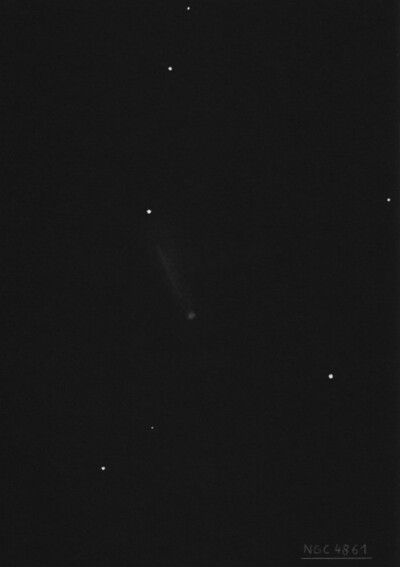
Max Wolf found IC 3961 = W. V-103 in 1903 on a Heidelberg plate. His postion, comments ("pL, pF, elongated in PA 30°) and note ("between two mag 12 stars") matches NGC 4861. Harold Corwin notes that one of the mag 12 stars is the prominent HII region. See NGC 4861.
UGC and CGCG identify the main galaxy as IC 3961 and the bright HII knot as NGC 4861 (Webb Society Quarterly Journal #45, July 1981). Although LdR noted a "bright little knot" at the south end, the HII complex was not given a separate designation in the NGC or IC.
300/350mm - 13.1" (2/23/85): faint, elongated streak SSW-NNE. Stretches between two 12th magnitude "stars". The star at the south end is actually a giant HII region and it appears slightly fuzzy at 166x and clearly nonstellar at 312x.
400/500mm - 17.5" (1/23/93): faint, very elongated SSW-NNE, even low surface brightness. Located between two mag 12 stars at low power. The "star" at the SSW end is slightly nebulous at 166x and appears as a definite nonstellar knot at 332x. UGC and CGCG misidentify this HII region as NGC 4861 (and the galaxy as IC 3961). This is one of the few extragalactic HII regions which responds to OIII filtration.
900/1200mm - 48" (4/7/13): very unusual appearance at 488x as the galaxy is dominated by a very high surface brightness HII region (Mrk 59) at the SSW end, about 15" in diameter and 13th magnitude. The knot appeared extremely bright, roundish, sharp-edged. The main glow of the galaxy is very elongated to the NNE, 3.0'x 0.6', extending just past a mag 13 star near the opposite end. The core is a somewhat brighter, elongated, knotty region, offset closer to the giant HII region. The glow of the galaxy dims as it extends to the star at the opposite end and fades out just beyond. PGC 101479, a compact galaxy, is exactly in line with the major axis of NGC 4861, 3.5' NNE of the mag 12 star. It appeared faint or fairly faint (B = 16.8), round, 12"-15" diameter.
Notes by Steve Gottlieb